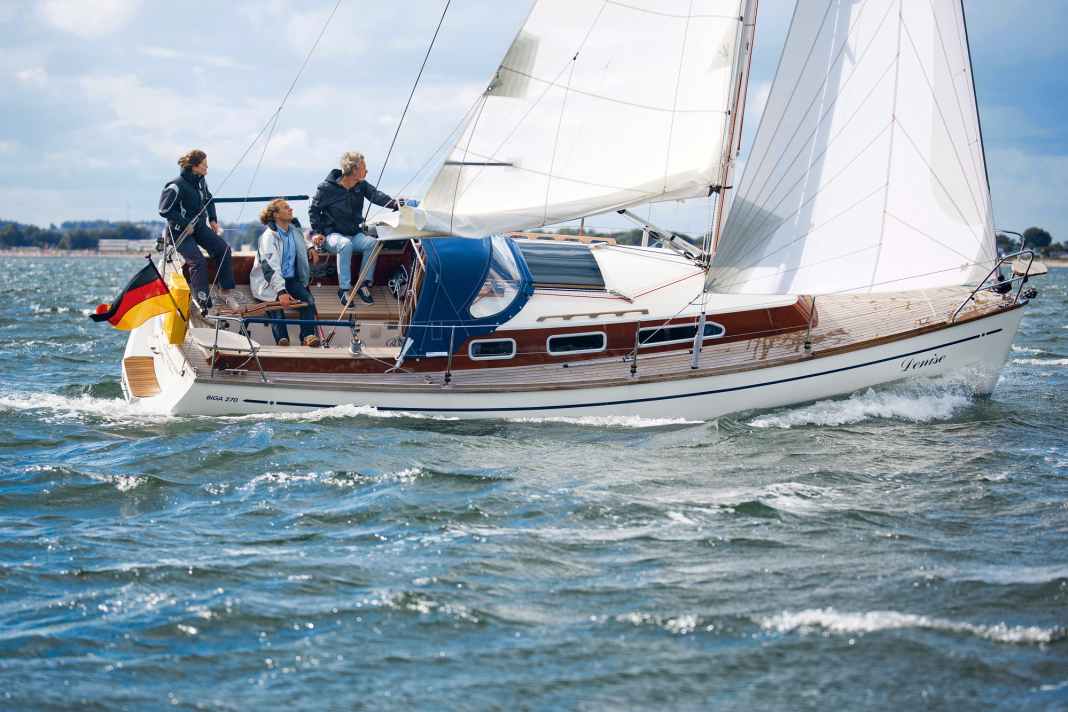





On the jetty, every passer-by involuntarily stops in front of the Biga 270: The wooden surfaces gleam under the clear varnish, and the hull, which is only 2.55 metres wide, is also an eye-catcher in view of today's more expansive designs. Designer Juliane Hempel and Sven Wehrenbrecht, boat builder at the Bicker shipyard, proudly show YACHT the then new cruising yacht during a test in summer 2016. As the wind howls through the rigging at over 25 knots and the next cloud front announces itself with rain, it's time to go below deck. Where there is cause for further amazement: No plastic is visible here, it almost feels like being on a classic. The mahogany deck beams convey a feeling of warmth and solidity.
The dinette in the saloon invites you to sit down comfortably - even before the interior fittings are subjected to a critical inspection, it already exudes cosiness. Four people can sit together around the table. The first details catch the eye: a view to the outside, a handrail from the companionway to the main bulkhead ensures a secure hold throughout the saloon, stainless steel struts absorb the forces of the lower shrouds attached on the inside (in your head you recapitulate the clear path on deck between the shrouds from the foredeck to the aft), and a drawer above the dog berth raises the question of what is stowed there.
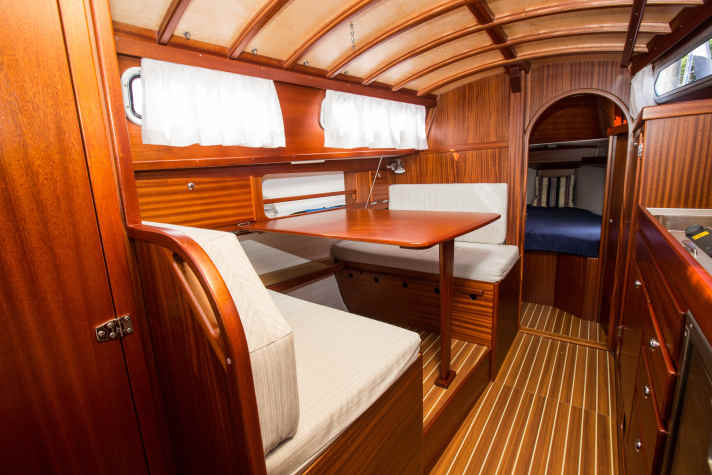
The Biga 270 fits perfectly between 242 and 292
But before the details, the question arises as to why Bicker is launching a new boat at all. Sven Wehrenbrecht explains that many customers wanted to upsize from the Biga 242, but were reluctant to buy the 292 because it could no longer be trailered. "We could have sold a lot more 292s if they could still fit on a trailer," says the boat builder. The assumption seems to have been confirmed, as four sales were already reported at that time without the boat having been to a trade fair. This is certainly also due to the exciting size segment.
Only 8.50 metres long, the Biga 270 fits on a trailer. That sounds like a weekender. But below deck it feels like a cosy cruising boat, partly because everything you need for longer trips is there. With a length of 2.06 metres and a shoulder width of 1.45 metres, the bow berth is quite spacious, while large cupboards, the wet room and a fully-fledged galley underline this impression. The latter comes without a semi-cardanically suspended cooker. However, according to Wehrenbrecht, future owners can negotiate everything with the shipyard; as everything is manufactured in-house, many special requests can be accommodated. A different cooker or refrigerator is just the beginning of the customisation - the superstructure can be made higher or the berth can be made longer by moving the bulkhead.
The front is through. Time to go sailing.
Good manoeuvrability under engine
The Großenbrode ferry harbour is quite narrow and winding, and the Biga 270 backs out of the box. The cruising yacht from the Bicker shipyard can be steered precisely with the tiller. The three-bladed fixed pitch propeller provides plenty of thrust. As soon as the forward gear is engaged, the boat stops and immediately picks up speed again. With the rudder wide open, it turns towards the harbour exit.
The wind is gusty at 17 to 24 knots. However, there is only a small wave under land, but the gusts are more unpredictable here. Under full sail, i.e. 20.4 square metre mainsail and 115 percent genoa with 17.8 square metres, we head east out of the Fehmarnbelt with a stern wind. The log oscillates between 6 and 7 knots, the genoa is set as a butterfly. It is not boomed out for the short stretch and the main is not secured with a bull bollard. The boat only stays on course by steering sensitively, and even in the gusts it does not break away.
At the tiller you can feel what the Biga 270 is doing
As soon as we go upwind, the sail area, which is a little too large for these conditions, becomes noticeable. We still log 5.7 knots upwind, but in the gusts the heeling is too great for optimum sailing. At least the boat remains controllable at all times. At the tiller, you can feel what the Biga 270 is doing, only in the gusts can you really talk about rudder pressure. You don't have to fiddle with the helm, but you still get enough feedback. These characteristics are thanks to the modern underwater hull and the appendages.
A pre-balanced spade rudder hangs from the flat U-frame and the lead ballast from a GRP fin. This construction method is expensive and normally only found in regattas; originally a cast-iron keel was planned. However, as this would have placed the centre of gravity higher up, it would have had to be considerably heavier to achieve the same stability. However, the Biga was to remain trailerable, so Juliane Hempel decided in favour of this solution.
This naturally results in greater moments at the keel-hull connection, which in turn are absorbed by a floor assembly made of laminated mahogany frames and construction foam. Steel was not used in order to save weight. The positive moulds for the lead bulb and rudder are milled by the shipyard and the negative mould is taken from them, thus achieving a high degree of precision. Doing everything yourself takes time, but Bicker relies on a high level of vertical integration and quality. This means that even unusual requests are no problem.
Three months construction time for a Biga 270
"Most buyers come round two or three times during the construction phase," says Wehrenbrecht. The relationship with the customer is almost familial, so to speak. Eight to ten boats are built each year. All the bulkheads and interior fittings are installed while the hull is still in the mould and has additional time to harden. It takes three months to build a Biga 270.
Another price driver: instead of a dinette, the standard layout with opposite saloon benches and galley next to the companionway is also available. In return, the dog bunk is omitted. There is also a shallower version for the keel and a 1.60 metre deep performance version.
After the next strong gust, the first reef in the main is a good idea. Sailing immediately becomes more comfortable. With less layline, the Biga 270 is still travelling just as fast as before. In particularly strong gusts, it is enough to reef the traveller a little.
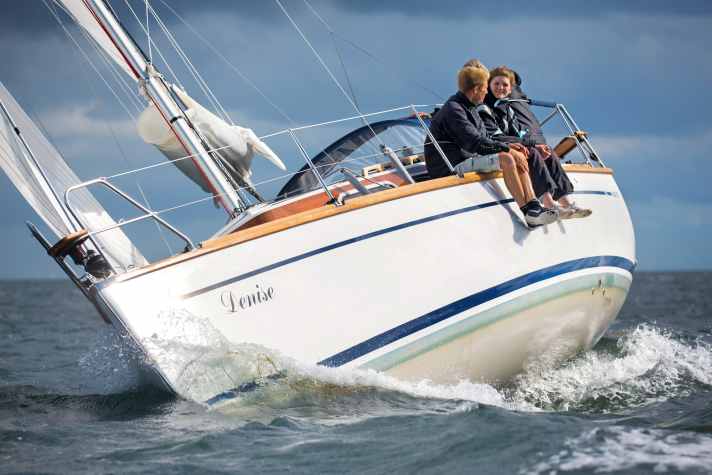
Sailing with the Biga 270 is simply a pleasure
The small boat conveys safety even in crisp gusts. After a few strokes, it is clear that the tacking angle is also impressive. The main stays well despite the reef, and the Biga turns at an angle of 90 degrees. The helmsman sits behind the traveller with the high coaming behind him. The opposite bulwark offers good support for the feet, and the mainsheet cleat and traveller are within easy reach.
You can also sit comfortably at the helm on the coaming and steer using the tiller jib. However, this can be uncomfortable in rough conditions - there is no support for the feet and there is a risk of slipping. It's better to take a relaxed seat in the cockpit. The view forwards is also good from below on the seat thwarts. The plotter in the companionway bulkhead is used for navigation; there is no separate chart table. Nevertheless, there are charts on board, which are located in the compartment above the dog bunk that aroused interest at the beginning. If this is pulled out, the charts can even be studied in full size.
In the meantime, we've crossed close to land - time to drop and let the Biga 270 run with a clear wind. The log climbs to over 7 knots. That is simply a joy. Now it's time to head out and look forward to the next strong gust.
Despite a lot of wood, the Biga 270 is easy to maintain
Ahead, where the white-spotted water turns into grey sky, should be Poel. You really feel like just sailing on. But it's back again, upwind. Nevertheless, every metre to the harbour entrance is fun. This boat wants to be sailed, no question about it.
One concern then arises when looking at the varnished wooden surfaces: Do owners have to reach for a paintbrush every winter? Up to nine coats of PU varnish mean that the boat is very easy to maintain, says boat builder Wehrenbrecht. Only after five years should it be sanded once and given another coat. Then you can enjoy sailing again for years to come.
Measured values Biga 270
Sailing performance, without drift and current
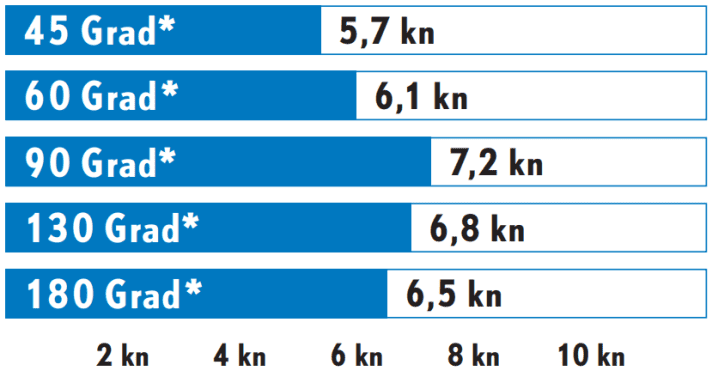
Wind: 17-24 kn (5-6 Bft.), wave height: swell approx. 0.3 metres
* With first reef in mainsail
Potential

The sail carrying capacity is quite high. The boat sails lively and sporty
Dimensionless number. Calculation: 2√S/3√V. The higher the value, the more sail area (S) the ship has in relation to the displacement (V)
Bunk mass
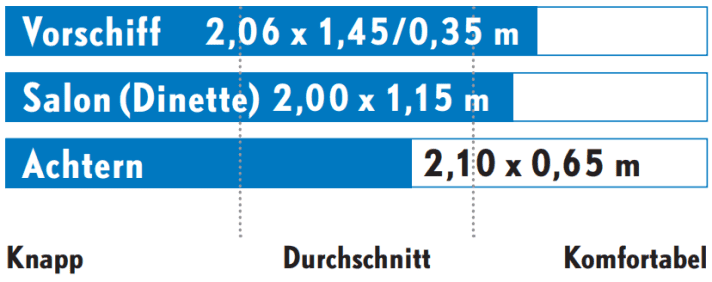
YACHT review Biga 270
The Biga 270 is trailerable, but still offers comfort for longer trips. Thanks to the modern hull shape and attachments by designer Juliane Hempel, it sails agilely and can be safely controlled even in stronger winds
Design and concept
- + Classic look with lots of wood
- + Modern appendices
- + Trailer bar due to slim lines
- - High base and end price
Sailing performance and trim
- + Plenty of sail area
- + Good controllability even in strong winds
Living and finishing quality
- + Plenty of light, good ventilation
- + Very high quality craftsmanship
- - No standing height (maximum 1.74 metres)
Equipment and technology
- + Folding mast and removable traveller
- + Swimming ladder accessible from the water
Technical data Biga 270
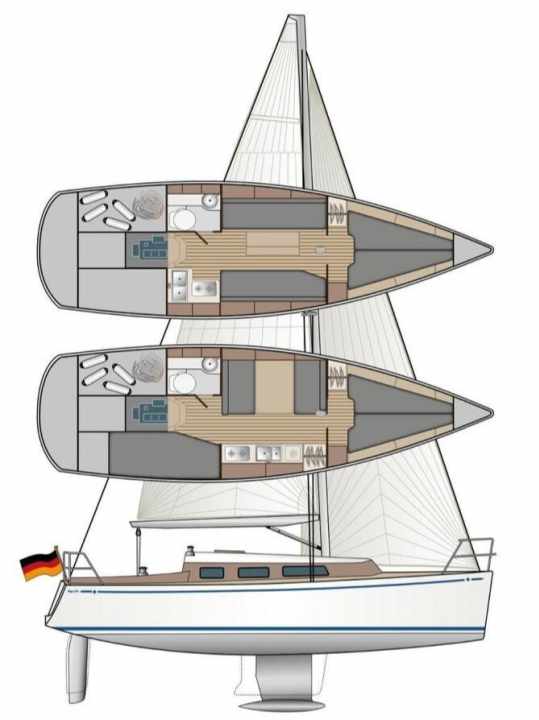
- Designer: Juliane Hempel
- CE design category: B
- Torso length:8,50 m
- Width:2,55 m
- Draught/alternative: 1,15/1,45 m
- Weight: 2,3 t
- Ballast/alternative: 0,86/0,75 t
- Mainsail: 20,4 m²
- Furling genoa (115 %): 17,8 m²
- machine (Volvo Penta):13 kW/18 hp
Hull and deck construction
Hull: polyester full laminate in hand lay-up; sandwich in the bow. Superstructure made of marine plywood
Base price ex shipyard
109,000 € ex shipyard, gross incl. 19 % VAT (as of May 2023)
Shipyard and distribution
Gerhard Bicker boatyard, Uentroper Straße 33, 59229 Ahlen-Dolberg; www.biga-yachten.de
This test appeared in YACHT issue 24/2016 and was revised by the editorial team in May 2023.

